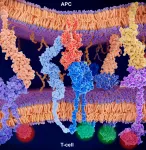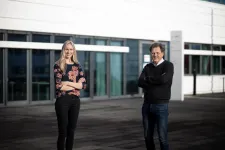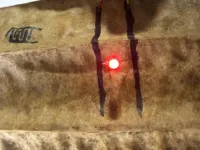The paper, entitled "Geographic monitoring for early disease detection (GeoMEDD)," appeared in the Dec. 10 issue of Nature Scientific Reports and comes from researchers at Case Western Reserve University (CWRU) School of Medicine, University Hospitals (UH) Cleveland Medical Center, and Texas A & M University.
While developing a tracking system during the beginning stages of the COVID-19 pandemic, the authors realized that there was a need to refocus more traditional spatial mapping towards a more granular cluster detection methodology that provides syndromic surveillance, or early indicators of emergent disease by leveraging a health system's access to data streams from various sources which account for location and timing of cases.
"Without such integration, there are missed opportunities for hospitals, health departments, and community leaders to mobilize early intervention activities and save lives. This information provides insights to targeted community testing opportunities, post-acute care intervention, and targeted community education in areas with community spread," said lead author Andrew Curtis, PhD, Co-Director of the GIS Health & Hazards Lab and Professor in the Department of Population and Quantitative Health Sciences at the CWRU School of Medicine.
"From a hospital and health system perspective, such disease propagation can rapidly tax capacity and resources. From a humanitarian dimension, being able to communicate with local communities, municipality or even building managers requires both time and space insights," said Curtis.
The authors propose, for example, that positive COVID-19 test results could be analyzed in real time as they flow into a health system, which when combined with severity of the associated symptoms, details such as age and previous medical histories of the patient, and the background neighborhood "risk" could all be added to provide a contextualized understanding of not only where disease occurs but why, and where it is likely to spread next.
"Early detection is critical to interception and potential spread of disease, and is helpful at identifying areas of vulnerability so that efforts can be adequately prioritized," said Jayakrishnan Ajayakumar, PhD, Lab Manager of the GIS Health & Hazards Lab in the Department of Population and Quantitative Health Sciences at the CWRU School of Medicine, who developed the necessary software. "The tracking system also helps prepare medical and first response teams for potential surge planning."
GeoMEDD does not replace traditional forms of disease cluster detection, rather it enhances investigation in near real-time and in the context of health system operations to a dynamic situation.
"Syndromic surveillance interest lies in the first case in a post-acute care home, or the timing pattern of emerging positives in an apartment complex, or along a rural street, or how houses on city streets 'emerge' suggesting a local transmission mechanism," said Maulik Purohit, MD, MPH, Associate Chief Medical Information Officer at UH. "With this information, teams can mobilize to minimize the spread. This methodology will be relevant for many infectious diseases and operational responses, not just COVID."
By identifying these emergent patterns in the continuous data streams available to health systems, rational and evidence-based strategies could potentially be used to reduce further transmission.
"COVID spreads very efficiently in congregate housing and narrowing the time lag between knowledge of an emergent case and implementation of evidence-based interventions could help to save lives," said Justin Yax, DO, Director of Population Health, Department of Emergency Medicine at UH.
These data have also been helpful to local health departments and community leaders and has gained interest and support from the state.
While contact tracing remains a vital part of understanding disease spread, the clusters described here reveal geographic patterns and aspects of diffusion in near real time -- much sooner than other public health monitoring currently available in the region.
While COVID-19 provided the stimulus for these new method developments, the application extends far beyond this pandemic to potentially other future epidemics, to regular flu seasons, to outbreaks of overdoses, and to surveillance looking for bioterror or radiological symptoms.
"GeoMEDD should be seen as the first step in the development of a suite of clusters nuanced to varying geographies (urban versus rural, even vertical living environments), or specific topics," said Jacqueline Curtis, PhD, Co-Director of the GIS Health & Hazards Lab and Associate Professor in the Department of Population and Quantitative Health Sciences at the CWRU School of Medicine.
INFORMATION:
About University Hospitals
Founded in 1866, University Hospitals serves the needs of patients through an integrated network of 19 hospitals, more than 50 health centers and outpatient facilities, and 200 physician offices in 16 counties throughout northern Ohio. The system's flagship academic medical center, University Hospitals Cleveland Medical Center, located in Cleveland's University Circle, is affiliated with Case Western Reserve University School of Medicine. The main campus also includes University Hospitals Rainbow Babies & Children's Hospital, ranked among the top children's hospitals in the nation; University Hospitals MacDonald Women's Hospital, Ohio's only hospital for women; University Hospitals Harrington Heart & Vascular Institute, a high-volume national referral center for complex cardiovascular procedures; and University Hospitals Seidman Cancer Center, part of the NCI-designated Case Comprehensive Cancer Center. UH is home to some of the most prestigious clinical and research programs in the nation, including cancer, pediatrics, women's health, orthopedics, radiology, neuroscience, cardiology and cardiovascular surgery, digestive health, transplantation and urology. UH Cleveland Medical Center is perennially among the highest performers in national ranking surveys, including "America's Best Hospitals" from U.S. News & World Report. UH is also home to Harrington Discovery Institute at University Hospitals - part of The Harrington Project for Discovery & Development. UH is one of the largest employers in Northeast Ohio with 28,000 physicians and employees. Advancing the Science of Health and the Art of Compassion is UH's vision for benefitting its patients into the future, and the organization's unwavering mission is To Heal. To Teach. To Discover. Follow UH on LinkedIn, Facebook @UniversityHospitals and Twitter @UHhospitals. For more information, visit UHhospitals.org.
About Case Western Reserve University
Case Western Reserve University is one of the country's leading private research institutions. Located in Cleveland, we offer a unique combination of forward-thinking educational opportunities in an inspiring cultural setting. Our leading-edge faculty engage in teaching and research in a collaborative, hands-on environment. Our nationally recognized programs include arts and sciences, dental medicine, engineering, law, management, medicine, nursing and social work. About 5,100 undergraduate and 6,700 graduate students comprise our student body. Visit case.edu to see how Case Western Reserve thinks beyond the possible.



